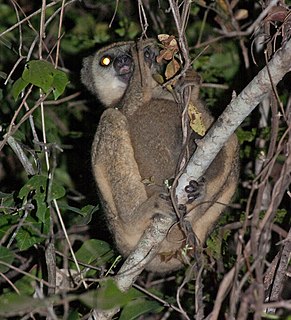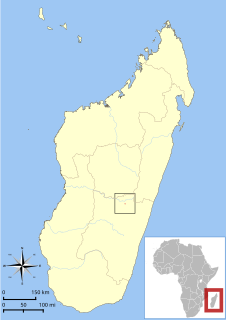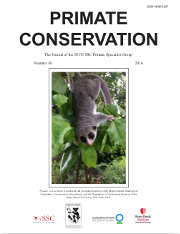
The Cheirogaleidae are the family of strepsirrhine primates containing the various dwarf and mouse lemurs. Like all other lemurs, cheirogaleids live exclusively on the island of Madagascar.

The woolly lemurs, also known as avahis or woolly indris, are nine species of strepsirrhine primates in the genus Avahi. Like all other lemurs, they live only on the island of Madagascar.

The fat-tailed dwarf lemur, also known as the lesser dwarf lemur, western fat-tailed dwarf lemur, or spiny forest dwarf lemur, is endemic to Madagascar.

The hairy-eared dwarf lemur, or hairy-eared mouse lemur, is one of the most scarcely known lemurs. A. trichotis is a nocturnal lemur that is endemic to Madagascar. It was originally named by Albert Günther in 1875 as Cheirogaleus trichotis as part of the Cheirogaleidae family, or the dwarf lemurs. In 1967 Petter-Rousseaux and Petter reassigned the lemur to its own genus and is the now only member of the genus Allocebus. The hairy-eared dwarf lemur was thought to be extinct until its rediscovery in 1989 in a northeastern primary lowland rainforest. The population of these mammals is shown to be severely decreasing and largely fragmented throughout Northern and Eastern Madagascar rainforests; most likely due to hunting, trapping, slash-and-burn agriculture as well as habitat fragmentation.

The eastern woolly lemur, also known as the eastern avahi or Gmelin's woolly lemur, is a species of woolly lemur native to eastern Madagascar, where it lives in the wet tropical rainforest at low elevations along the eastern coast of the island or they can also inhabit the northern tip of the island with other species. The woolly lemur name refers to their thick, tightly curled hair, whereas their generic name avahi refers to their high-pitched defensive call. The eastern woolly lemur almost has an owl-look with its large eyes, small rounded head, and ears that are mostly hidden. This nocturnal animal weighs 1.0–1.3 kg (2.2–2.9 lb) and reaches a length of 27–29 cm (11–11 in) with a tail of 33–37 cm (13–15 in). Its diet consists mainly of leaves and buds with fruits, flowers, and bark.

The greater dwarf lemur, or the Geoffroy's dwarf lemur, is a lemur that is widely distributed over the primary and secondary forests near the eastern coast of Madagascar. They are also found in northern parts of Madagascar. Greater dwarf lemurs live in forests and dry scrub areas. The head and body of the greater dwarf lemur can range from 167 to 264 millimeters in length, and 164 to 600 grams. Their tails can range from 195 to 310 millimeters in length.

The furry-eared dwarf lemur, or Crossley's dwarf lemur, only found on the island of Madagascar, as with all other lemurs. It has a pelage coloration that is red-brown dorsally and gray ventrally. The eye-rings of this species are blackish and the ears are black inside and out. Cheirogaleus crossleyi species are obligated to hibernate during periods of food scarcity on the island of Madagascar. Cheirogaleus crossleyi species specifically undergo drastic fluctuations in temperature during hibernation.

The lesser iron-gray dwarf lemur, or large iron-gray dwarf lemur, is a small nocturnal lemur endemic to Madagascar. It is nocturnal and an arboreal quadruped, and is not very agile. It produces three types of vocalisation: a squeak, which is high in pitch and is produced with the mouth closed, and is used between infants and their mothers; a whistle, which is higher in pitch than the squeak, so it is hard to hear with human ears, and is used as a communicative and possibly territorial call; and a grunt, which is usually given in series and is very powerful, used when an individual is being attacked in its nest.

The dwarf lemurs are the lemurs of the genus Cheirogaleus. All of the species in this genus, like all other lemurs, are native to Madagascar.

Sibree's dwarf lemur is a small nocturnal lemur endemic to Madagascar.

The southern woolly lemur, or southern avahi, has been recently recognized as a separate species of woolly lemur in 2006 by Zaramody et al. It is a nocturnal and pair-living species. Groups can range from 2 to 5 individuals. A study in Sainte Luce forest revealed home range varied from 2.2 to 3.5 ha and that males can have larger home range and cover longer daily distances than females, in agreement with the territory defence and mate guarding hypotheses.
The Lavasoa dwarf lemur is a small, nocturnal strepsirrhine primate and a species of lemur that is endemic to three small, isolated patches of forest on the southern slopes of the Lavasoa Mountains in southern Madagascar. Fewer than 50 individuals are thought to exist. Its habitat lies in a transitional zone between three ecoregions: dry spiny bush, humid littoral forest, and humid forest. First collected in 2001 and thought to be a subpopulation of the furry-eared dwarf lemur (C. crossleyi), it was not formally described until 2013. It is one of six species of dwarf lemur, though the research that identified it also suggested the existence of many more new species.
The Montagne d'Ambre dwarf lemur or Andy Sabin's dwarf lemur is a species of dwarf lemur known only from Amber Mountain National Park and the surrounding area in northern Madagascar. It was identified in 2005, but not formally described until 2015. It is an endangered species, at risk from deforestation and possibly hunting from nearby human populations.
The Ankarana dwarf lemur or Sheth's dwarf lemur is a species of dwarf lemur, part of the C. medius group, known only from northern Madagascar. It has been found in two reserves as well as two protected areas. It was identified in 2014, but not formally described until 2016. Its conservation status has not been determined, but it is at risk from habitat destruction due to daily resource extraction by local human populations.

Primate Conservation is a journal published by the IUCN Species Survival Commission's Primate Specialist Group about the world's primates. First published as a mimeographed newsletter in 1981, the journal today publishes conservation research and papers on primate species, particularly status surveys and studies on distribution and ecology. Besides these regular papers, the journal has also been a significant place for primatologists to publish descriptions of new primate species in Primate Conservation.

Groves' dwarf lemur is a species of dwarf lemur known from Ranomafana and Andringitra national parks and surrounding areas in southeastern Madagascar. The identification was based on comparison of mitochondrial and nuclear gene sequences with other members of the C. crossleyi group. Individuals from this clade first came under genetic study in 1999 and were recognized as a new species in 2014, but it was not formally described until 2017. The lemur was named after mammalologist Colin Groves. Known from altitudes from 754 to 999 m, it is significantly larger than other members of the C. crossleyi group, with a 20 cm body length, a 29 cm tail, and a weight of 0.41 kg. While the conservation status of the new species has not yet been assessed, its presence in several national parks does not guarantee that it will not be threatened by deforestation ongoing on the island, or possibly by hunting.













